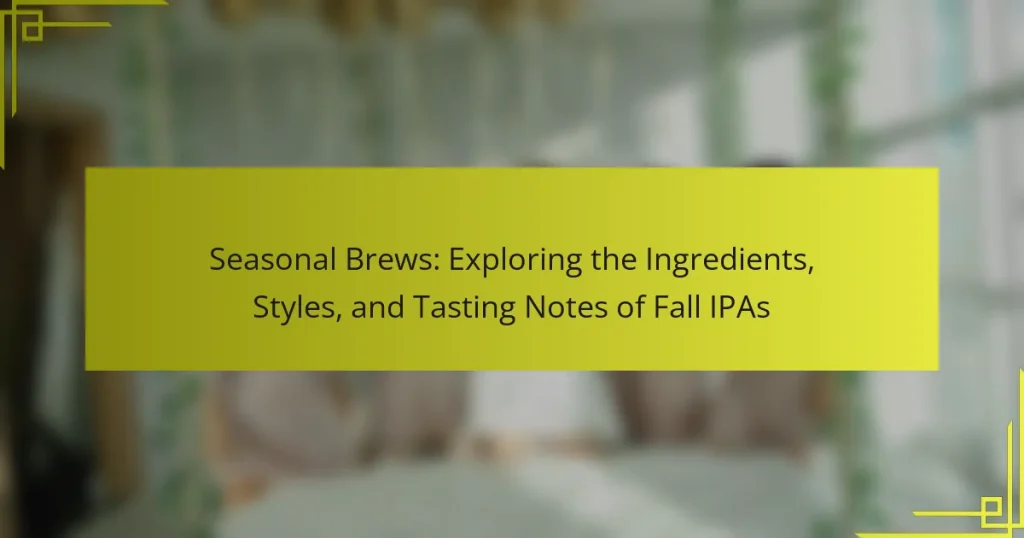Fall IPAs are India Pale Ales specifically crafted for the autumn season, characterized by ingredients that evoke seasonal flavors such as pumpkin and spices. These beers often have a malt-forward profile, balanced bitterness, and a rich amber color, differentiating them from traditional IPAs. Popular styles include New England IPAs, known for their hazy appearance and fruity flavors; West Coast IPAs, recognized for their clear look and resinous hop profiles; and Pumpkin IPAs, which blend classic IPA traits with seasonal spices. Best practices for tasting Fall IPAs involve using appropriate glassware, serving at the right temperature, and mindful observation of appearance and aroma, enhancing the overall tasting experience.

What are Fall IPAs and Why are They Unique?
Fall IPAs are India Pale Ales brewed specifically for the autumn season. They often feature ingredients that evoke the flavors and aromas associated with fall. Common attributes include the use of pumpkin, spices, and malt-forward profiles. These ingredients contribute to a unique taste that differentiates them from traditional IPAs. Fall IPAs typically have a balanced bitterness and a rich, amber color. The seasonal nature of these brews makes them appealing to consumers looking for flavors that match the cooler weather. Breweries often release limited editions, enhancing their uniqueness. This seasonal aspect creates anticipation among craft beer enthusiasts.
How do Seasonal Brews Differ from Regular IPAs?
Seasonal brews differ from regular IPAs primarily in their ingredients and flavor profiles. Seasonal brews often incorporate unique ingredients that reflect the time of year, such as spices or seasonal fruits. Regular IPAs typically have a consistent hop profile and malt backbone.
For example, fall seasonal brews may feature pumpkin or cinnamon, while summer IPAs may include citrus or tropical fruits. These variations create distinct tasting experiences that align with seasonal themes.
Additionally, seasonal brews are often produced in limited quantities, making them unique and sought after. Regular IPAs are usually available year-round, providing a stable offering for consumers.
What ingredients are typically used in Fall IPAs?
Fall IPAs typically use a combination of malt, hops, and additional flavoring ingredients. The malt often includes caramel and crystal malts, which add sweetness and color. Hops used in Fall IPAs are usually earthy and spicy varieties, such as Cascade, Centennial, and Simcoe. These hops contribute to the aromatic profile and bitterness. Additionally, some brewers incorporate seasonal ingredients like pumpkin, cinnamon, or nutmeg to enhance the fall theme. The use of these ingredients creates a balanced and flavorful beer that reflects the season.
How does the brewing process change for Fall IPAs?
The brewing process for Fall IPAs incorporates seasonal ingredients and adjusted techniques. Brewers often use malt varieties that add richer, caramel flavors. This enhances the beer’s body and sweetness, appealing to autumn tastes. Hops may shift to varieties that provide earthy, spicy notes, complementing seasonal flavors. The fermentation temperature can be slightly adjusted for fruity esters. Additionally, some brewers add spices like cinnamon or nutmeg during the brewing process for a seasonal twist. This combination creates a unique flavor profile distinct from traditional IPAs. These changes reflect the seasonal shift in consumer preferences towards warmer, comforting flavors.
What are the Key Characteristics of Fall IPAs?
Fall IPAs are characterized by their balance of malt sweetness and hop bitterness. These beers often feature autumnal flavors, such as pumpkin, spice, and caramel. The malt profile typically includes caramel and toffee notes, contributing to a richer mouthfeel. Hops used in Fall IPAs may include varieties that impart earthy or floral aromas. The ABV (alcohol by volume) usually ranges from 5.5% to 7.5%, providing a moderate strength. Fall IPAs often have a slightly amber to copper color, reflecting their malt content. Seasonal ingredients like cinnamon or nutmeg may also be incorporated to enhance flavor. These characteristics create a warm and inviting beer ideal for cooler weather.
What flavor profiles can be expected from Fall IPAs?
Fall IPAs typically feature flavor profiles that include notes of pumpkin, spice, and malt. These flavors are often complemented by citrus and pine characteristics from the hops. The use of seasonal ingredients like pumpkin and spices enhances the overall taste experience. Additionally, the malt backbone provides a rich sweetness that balances the bitterness from the hops. The combination of these elements creates a unique and inviting flavor profile. Many Fall IPAs also exhibit a medium to full body, contributing to a satisfying mouthfeel. Overall, these beers reflect the essence of the autumn season through their diverse and vibrant flavors.
How do the aromas of Fall IPAs enhance the tasting experience?
The aromas of Fall IPAs enhance the tasting experience by adding complexity and depth to the flavor profile. These aromas often include notes of pine, citrus, and spices, which evoke the essence of the season. The aromatic compounds interact with taste receptors, amplifying the overall sensory experience. For example, the presence of hops like Cascade or Centennial contributes floral and citrus aromas. These scents can lead to heightened anticipation and enjoyment before the first sip. Research indicates that aroma accounts for a significant portion of flavor perception. This interplay between scent and taste makes Fall IPAs uniquely enjoyable during the autumn months.
What Role do Seasonal Ingredients Play in Fall IPAs?
Seasonal ingredients play a crucial role in Fall IPAs by enhancing flavor profiles and reflecting autumn themes. These ingredients often include spices like cinnamon, nutmeg, and pumpkin. They contribute warmth and complexity to the beer’s taste. Additionally, seasonal hops may be used to create unique bitterness and aroma. The use of these ingredients aligns with consumer expectations for fall flavors. Breweries often market these IPAs as limited editions to create excitement. Seasonal ingredients also help differentiate Fall IPAs from other styles. This practice is rooted in tradition, as many cultures celebrate harvests with special brews. Overall, seasonal ingredients are essential for creating distinctive Fall IPAs that resonate with drinkers.
Which spices and fruits are commonly featured in Fall IPAs?
Common spices featured in Fall IPAs include cinnamon, nutmeg, and ginger. These spices enhance the seasonal flavor profile. Fruits commonly used are pumpkin, apple, and pear. Pumpkin is particularly popular for its association with fall. Apple and pear add sweetness and tartness. These ingredients combine to create a warm, inviting taste. Fall IPAs often emphasize these flavors to resonate with the season.
How do these ingredients influence the overall taste and aroma?
Ingredients in Fall IPAs significantly influence their overall taste and aroma. Hops contribute bitterness and floral notes, enhancing aroma complexity. Malts add sweetness and body, balancing hop bitterness. Seasonal spices like cinnamon or nutmeg introduce warmth and depth. The combination creates a rich sensory experience. Research indicates that specific hop varieties can impart unique citrus or pine characteristics, affecting overall perception. Additionally, malt selection impacts sweetness levels, further shaping flavor profiles.

What Styles of Fall IPAs are Popular?
Popular styles of fall IPAs include New England IPAs, West Coast IPAs, and Pumpkin IPAs. New England IPAs are known for their hazy appearance and juicy, fruity flavors. These beers often feature hops like Citra and Mosaic. West Coast IPAs are characterized by their clear appearance and piney, resinous hop profiles. They typically use hops such as Cascade and Centennial. Pumpkin IPAs blend traditional IPA characteristics with pumpkin spice flavors. They often incorporate ingredients like cinnamon and nutmeg for a seasonal twist. Each style caters to different taste preferences while celebrating autumnal ingredients.
How do Different Brewing Techniques Affect Fall IPA Styles?
Different brewing techniques significantly influence the flavor, aroma, and overall character of Fall IPA styles. Techniques such as dry hopping enhance hop aroma and flavor without increasing bitterness. This method adds fresh, fruity notes that complement seasonal ingredients like pumpkin or spice.
Additionally, variations in fermentation temperature can affect ester and phenol production. Lower temperatures may yield cleaner profiles, while higher temperatures can introduce fruity or spicy characteristics.
Mash temperature adjustments also play a role. Higher mash temperatures create a fuller body and sweetness, balancing the bitterness of hops. Conversely, lower mash temperatures result in a drier finish, allowing hop flavors to shine.
Lastly, the choice of yeast strains can greatly impact the final product. Certain strains may emphasize citrus or pine notes, while others can bring out floral or herbal undertones.
These brewing techniques collectively shape the unique profile of Fall IPAs, making them distinct and reflective of the season.
What are the most common brewing styles for Fall IPAs?
The most common brewing styles for Fall IPAs include American IPA, New England IPA, and West Coast IPA. American IPAs typically feature a strong hop character with balanced malt sweetness. They often showcase citrus and pine flavors, making them popular in the fall season. New England IPAs are known for their hazy appearance and juicy, fruity hop profiles. These beers are less bitter and have a smooth mouthfeel, appealing to many during the autumn months. West Coast IPAs emphasize a crisp, clean finish with prominent hop bitterness and resinous flavors. This style remains a favorite among craft beer enthusiasts in the fall.
How do variations in hop usage create distinct styles?
Variations in hop usage create distinct styles by altering flavor, aroma, and bitterness profiles. Different hop varieties contribute unique characteristics. For example, citrus-forward hops like Citra impart bright, fruity notes. In contrast, earthy hops such as Fuggle provide a more herbal quality. The timing of hop additions during brewing also affects the final product. Early additions enhance bitterness, while late or dry hopping boosts aroma. This technique influences the overall balance and drinkability of the beer. Additionally, the quantity of hops used can intensify these effects. Breweries often experiment with hop combinations to develop signature styles. This results in a diverse range of IPAs, each with its own identity.
What Are Some Notable Examples of Fall IPAs?
Notable examples of Fall IPAs include Dogfish Head’s “Fallen Angel” and Sierra Nevada’s “Harvest Ale.” Fallen Angel features a blend of autumn spices and hops. It offers a unique flavor profile that complements the season. Harvest Ale showcases fresh hops and a balanced malt backbone. This IPA is brewed with ingredients harvested in the fall. Other examples are Founders Brewing’s “Harvest Ale” and Stone Brewing’s “Autumn IPA.” These beers reflect the seasonal characteristics of fall. They emphasize earthy and spicy notes that resonate with autumn flavors.
Which breweries are known for their Fall IPAs?
Sierra Nevada Brewing Co., Dogfish Head Craft Brewery, and Founders Brewing Co. are known for their Fall IPAs. Sierra Nevada offers the “Flipside IPA,” which features a balanced malt profile. Dogfish Head is recognized for its “Namaste White,” a Belgian-style IPA with fall spices. Founders Brewing produces the “Harvest Ale,” which showcases fresh hops and malt. These breweries consistently create seasonal IPAs that reflect autumn flavors.
What are the standout features of these notable Fall IPAs?
Notable Fall IPAs are characterized by their rich malt profiles and balanced hop bitterness. These beers often feature autumnal ingredients such as pumpkin, spices, and caramel malts. The malt sweetness provides a foundation that complements the hop flavors. Common hop varieties used include Cascade and Centennial, which add citrus and floral notes. Many Fall IPAs have an amber to deep copper color, presenting a visually appealing appearance. The alcohol content typically ranges from 5.5% to 7.5%, providing a warming sensation suitable for cooler weather. Seasonal releases often emphasize limited availability, enhancing their uniqueness. Overall, these characteristics make Fall IPAs distinctive within the craft beer landscape.

What are the Best Practices for Tasting Fall IPAs?
The best practices for tasting Fall IPAs include proper glassware, temperature control, and mindful observation. Use a clean, clear glass to appreciate the beer’s color and clarity. Serve Fall IPAs at a slightly warmer temperature, around 45-55°F, to enhance flavor profiles. Observe the beer’s appearance first, noting color and head retention. Swirl the beer gently to release aromas. Inhale deeply to identify hops, malt, and seasonal spices. Take small sips to allow flavors to develop on the palate. Note the mouthfeel and aftertaste for a comprehensive tasting experience. These practices enhance enjoyment and understanding of the unique characteristics of Fall IPAs.
How Should Fall IPAs be Served for Optimal Enjoyment?
Fall IPAs should be served chilled at a temperature between 45°F to 50°F. This temperature range enhances the hop aromas and balances the malt sweetness. Use a tulip or snifter glass to concentrate the aromas. Pour the IPA gently to maintain carbonation and avoid excessive foam. Allow the beer to breathe for a few minutes after pouring. This helps in releasing complex flavors. Pairing with seasonal foods like roasted squash or spiced dishes complements the beer’s profile. Serving in the right glassware and at the correct temperature maximizes the tasting experience.
What glassware is recommended for tasting Fall IPAs?
A tulip glass is recommended for tasting Fall IPAs. This glass shape enhances the aroma and flavor profile of the beer. The tapered top helps concentrate the hops’ aromas. Additionally, the wider bowl allows for better head retention. Using a tulip glass can improve the overall tasting experience. Many beer enthusiasts prefer this glass for IPAs. Its design is widely recognized in craft beer culture.
What temperature is ideal for serving Fall IPAs?
The ideal temperature for serving Fall IPAs is between 45°F to 55°F. This temperature range allows the flavors and aromas to be fully expressed. Serving at this temperature enhances the maltiness and hop character typical of Fall IPAs. It also balances the sweetness with the bitterness. Many beer enthusiasts agree that slightly warmer temperatures improve the tasting experience. Research shows that temperature affects the perception of flavor in beer. Thus, serving Fall IPAs within this range maximizes enjoyment.
What Tips Can Enhance the Tasting Experience of Fall IPAs?
To enhance the tasting experience of Fall IPAs, serve them at the right temperature. A temperature between 45°F to 55°F is ideal. This range allows the flavors to bloom. Use a proper glass, such as a tulip or pint glass, to concentrate the aromas. Swirling the beer in the glass can release more fragrance. Take time to smell the beer before tasting. Aromas play a crucial role in flavor perception. Sip slowly to appreciate the complex flavors. Noting the balance of malt and hops is essential. Pair Fall IPAs with seasonal foods like roasted squash or spicy dishes for a complementary experience.
How can food pairings elevate the enjoyment of Fall IPAs?
Food pairings can significantly elevate the enjoyment of Fall IPAs by enhancing their flavors. Complementary flavors in food can bring out the rich, malty notes of these beers. For example, roasted meats can highlight the caramel and toasty characteristics of Fall IPAs. Similarly, spicy dishes can contrast with the bitterness, creating a balanced taste experience. Pairing with cheese, like sharp cheddar, can enhance the beer’s hoppy aroma. Additionally, sweet desserts can play off the beer’s malt sweetness, creating a satisfying finish. Studies show that specific food and beer pairings can improve overall tasting experiences by 30%.
What are some common tasting notes to look for in Fall IPAs?
Common tasting notes in Fall IPAs include caramel malt, pine, and citrus. These flavors often reflect the seasonal ingredients used in brewing. Caramel malt adds sweetness and body, enhancing the beer’s richness. Pine notes come from specific hop varieties, contributing a resinous character. Citrus flavors, such as orange or grapefruit, provide a bright contrast. Additionally, some Fall IPAs exhibit earthy undertones from the use of certain hops. The balance of these flavors creates a complex tasting experience. Many breweries emphasize these notes to align with the autumn season.
Seasonal Brews, specifically Fall IPAs, are India Pale Ales crafted for the autumn season, featuring unique ingredients such as pumpkin, spices, and malt-forward profiles that distinguish them from traditional IPAs. This article explores the key characteristics, brewing techniques, and flavor profiles of Fall IPAs, highlighting the role of seasonal ingredients and the differences between seasonal and regular IPAs. Additionally, it discusses popular styles, notable examples, and best practices for tasting these beers, including ideal serving temperatures and food pairings that enhance the overall experience.




